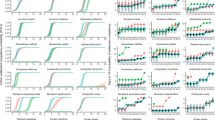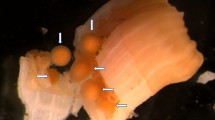Abstract
Broadcast spawning of gametes with planktonic development of larvae is the most common reproductive mode in tropical corals, and is generally thought to optimize the dispersal potential of larvae. To this end, many previous studies of coral larval dispersal have focused on the maximum time larvae can remain competent to settle and consequently how far they might disperse. However, dispersal ability of broadcast-spawned coral larvae will be linked, at least in part, to the minimum time to settlement competency as well as the length of the planktonic period—although estimates of minimum time to competency remain largely anecdotal, with few rigorous studies of the pre-competent period. To determine the minimum time to larval settlement in two species of broadcast-spawning coral (Platygyra daedalea and Goniastrea favulus), we monitored larval settlement rates in aquaria every 6 h from the time larvae commenced swimming (i.e. were ciliated, fully developed larvae) for a period of approximately 10 days. For P. daedalea, peak settlement occurred between 60 and 66 h following fertilization (2.5 and 2.75 days), which is markedly earlier than the 4- to 6-day time period commonly cited as the minimum time before broadcast-spawned coral larvae are competent to settle. Surprisingly, it was also clear from our experimental results that settlement in P. daedalea occurred as a distinct pulse during the 60- to 66-h period, rather than continuously throughout the study period. G. favulus larvae also appear to be able to settle quickly (from 54 h following fertilization). We argue, on the basis of these short competency times and apparently rapid settlement, that dispersal in broadcast-spawning coral larvae may not be as great as has previously been assumed.




Similar content being viewed by others
References
Ayre DJ, Hughes TP (2000) Genotypic diversity and gene flow in brooding and spawning corals along the Great Barrier Reef, Australia. Evolution 54(5):1590–1605
Babcock RC (1984) Reproduction and distribution of two species of Goniastrea (Scleractinia) from the Great Barrier Reef Province. Coral Reefs 2:187–195
Babcock RC (1985) Growth and mortality in juvenile corals (Goniastrea, Platygyra and Acropora): the first year. Proc 5th Int Coral Reef Symp 4:355–360
Babcock RC (1988) Fine-scale spatial and temporal patterns in coral settlement. Proc 6th Int Coral Reef Symp 2:635–639
Babcock RC, Heyward AJ (1986) Larval development of certain gamete spawning scleractinian corals. Coral Reefs 5:111–116
Babcock RC, Bull GD, Harrison PL, Heyward AJ, Oliver JK, Wallace CC, Willis BL (1986) Synchronous spawnings of 105 scleractinian coral species on the Great Barrier Reef. Mar Biol 90:379–394
Baird AH, Hughes TP (1997) Spatial variation in coral recruitment around Lizard Island, Australia. Proc 8th Int Coral Reef Symp 2:1207–1210
Baird AH, Babcock RC, Mundy CN (2003) Habitat selection by larvae influences the depth distribution of six common coral species. Mar Ecol Prog Ser (in press)
Black KP (1993) The relative importance of local retention and inter-reef dispersal of neutrally buoyant material on coral reefs. Coral Reefs 12:43–53
Black KP, Moran PJ, Hammond LS (1991) Numerical models show coral reefs can be self seeding. Mar Ecol Prog Ser 74:1-11
Bradbury IR, Snelgrove PVR (2001) Contrasting larval transport in demersal fish and benthic invertebrates: the roles of behaviour and advective processes in determining spatial pattern. Can J Fish Aquat Sci 58:811–823
Carlon DB, Olson RR (1993) Larval dispersal distance as an explanation for adult spatial pattern in two Caribbean reef corals. J Exp Mar Biol Ecol 173:247–263
Harriott VJ, Fisk DA (1988) Recruitment patterns of scleractinian corals: a study of three reefs. Aust J Mar Freshwater Res 39:409–416
Harrison PL, Wallace CC (1990) Reproduction, dispersal and recruitment of scleractinian corals. In: Dubinsky Z (eds) Coral reef ecosystems. Elsevier, Amsterdam, pp 133–207
Harrison PL, Babcock RC, Bull GD, Oliver JK, Wallace CC, Willis BL (1984) Mass spawning in tropical reef corals. Science 223:1187–1188
Havenhand JN (1995) Evolutionary ecology of larval types. In: McEdward L (ed) Ecology of marine invertebrate larvae. CRC Press, Boca Raton, pp 79–122
Heyward AJ, Babcock RC (1986) Self- and cross-fertilization in scleractinian corals. Mar Biol 90:191–195
Heyward AJ, Negri AP (1999) Natural inducers for coral larval metamorphosis. Coral Reefs 18:273–279
Keough MJ, Downes BJ (1982) Recruitment of marine invertebrates: the role of active larval choices and early mortality. Oecologia 54:348–352
Keough MJ, Klemke JE (1991) Larval dispersal and the scale of recruitment variation in benthic invertebrates. In: Proc Australian Society for Fish Biology Workshop, Recruitment Processes, Hobart. Bur Rural Resour Proc 16:64–70
Kojis BL, Quinn NJ (1981) Aspects of sexual reproduction and larval development in the shallow water hermatypic coral Goniastrea australensis (Edwards and Haime). Bull Mar Sci 31(3):558–573
Krug PJ (2001) Bet-hedging dispersal strategy of a specialist marine herbivore: a settlement dimorphism among sibling larvae of Alderia modesta. Mar Ecol Prog Ser 213:177–192
Maldonado M, Young CM (1999) Effects of duration of larval life on postlarval stages of the demosponge Sigmadocia caerulea. J Exp Mar Biol Ecol 232:9–21
Miller K (1994) Morphological species boundaries in the coral genus Platygyra: environmental influences and taxonomic implications. Mar Ecol Prog Ser 110:19–28
Miller KJ, Babcock RC (1997) Conflicting morphological and reproductive species boundaries in the scleractinian coral genus Platygyra. Biol Bull 192:98–110
Mundy CN, Babcock RC (1998) Role of light intensity and spectral quality in coral settlement: implications for depth-dependent settlement? J Exp Mar Biol Ecol 223:235–255
Mundy CN, Babcock RC (2000) Are vertical distribution patterns of scleractinian corals maintained by pre-settlement or post-settlement processes?: a case study of three contrasting species. Mar Ecol Prog Ser 198:109–119
Nozawa Y, Harrison PL (2003) Larval settlement patterns, dispersal potential, and the effect of temperature on settlement of larvae of the reef coral, Platygyra daedalea, from the Great Barrier Reef. Proc 9th Int Coral Reef Symp (in press)
Oliver J, Babcock R (1992) Aspects of the fertilisation ecology of broadcast spawning corals: sperm dilution effects and in situ measurements of fertilisation. Biol Bull 183:409–417
Olmi EJ (1994) Vertical migration of blue crab Callinectes sapidus magalopae: implications for transport in estuaries. Mar Ecol Prog Ser 113:39–54
Pechenik JA (1990) Delayed metamorphosis by larvae of benthic marine invertebrates: does it occur? Is there a price to pay? Ophelia 32:63–94
Raimondi PT, Keough MJ (1990) Behavioural variability in marine larvae. Aust J Ecol 15:427–437
Raimondi PT, Morse ANC (2000) The consequences of complex larval behaviour in a coral. Ecology 81:3193–3211
Sammarco PW, Andrews JC (1988) Localized dispersal and recruitment in Great Barrier Reef corals: the Helix experiment. Science 239:1422–1424
Sammarco PW, Andrews JC (1989) The Helix experiment: differential localized dispersal and recruitment patterns in Great Barrier Reef corals. Limnol Oceanogr 34:896–912
Scheltema RS (1986) On dispersal and planktonic larvae of benthic invertebrates: an eclectic overview and summary of problems. Bull Mar Sci 39(2):290–322
Shlesinger Y, Loya Y (1991) Larval development and survivorship in the corals Favia favus and Platygyra lamellina. Hydrobiologia 216/217:101–108
Sulkin SD (1990) Larval orientation mechanisms: the power of controlled experiments. Ophelia 32:49–62
Wallace CC (1985) Seasonal peaks and annual fluctuations in recruitment of juvenile scleractinian corals. Mar Ecol Prog Ser 21:289–298
Willis BL, Oliver JK (1988) Distribution of coral eggs and larvae in the central section of the Great Barrier Reef Marine Park following the annual mass spawning of corals. Report to Great Barrier Reef Marine Park Authority, Townsville, 49 pp
Willis BL, Oliver JK (1990) Direct tracking of coral larvae: implications for dispersal studies of planktonic larvae in topographically complex environments. Ophelia 32(1–2):145–162
Wilson JR, Harrison PL (1998) Settlement-competency periods of larvae of three species of scleractinian corals. Mar Biol 131:339–345
Wolanski E (1994) Physical oceanographic processes of the Great Barrier Reef. CRC Press, Boca Raton, 194 pp
Wolanski E, Burrage D, King B (1989) Trapping and dispersion of coral eggs around Bowden Reef, Great Barrier Reef, following mass coral spawning. Cont Shelf Res 9:479–496
Wray GA (1995) Evolution of larvae and developmental modes. In: McEdward L (ed) Ecology of marine invertebrate larvae. CRC Press, Boca Raton, pp 413–448
Young CM (1995) Behaviour and locomotion during the dispersal phase of larval life. In: McEdward L (ed) Ecology of marine invertebrate larvae. CRC Press, Boca Raton, pp 249–278
Acknowledgements
Thanks to the staff of One Tree Island Research Station—Pam and Konrad Beinssen, Anna Beinssen, and Oliver Hentschel—for accommodating our hectic schedule and requests during the course of this experiment. This study was funded by the Australian Research Council through a Post-Doctoral Fellowship Award (to K.M.).
Author information
Authors and Affiliations
Corresponding author
Rights and permissions
About this article
Cite this article
Miller, K., Mundy, C. Rapid settlement in broadcast spawning corals: implications for larval dispersal. Coral Reefs 22, 99–106 (2003). https://doi.org/10.1007/s00338-003-0290-9
Received:
Accepted:
Published:
Issue Date:
DOI: https://doi.org/10.1007/s00338-003-0290-9




